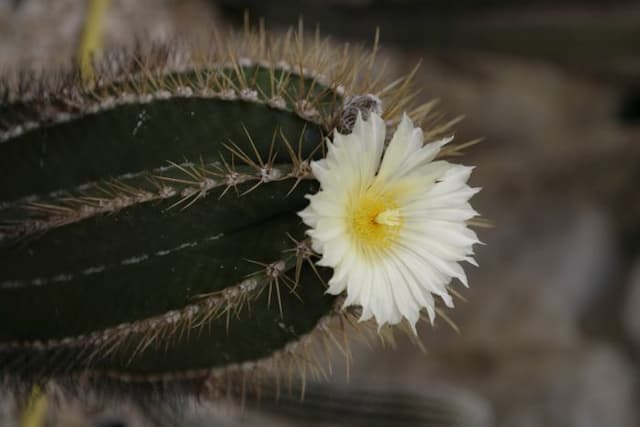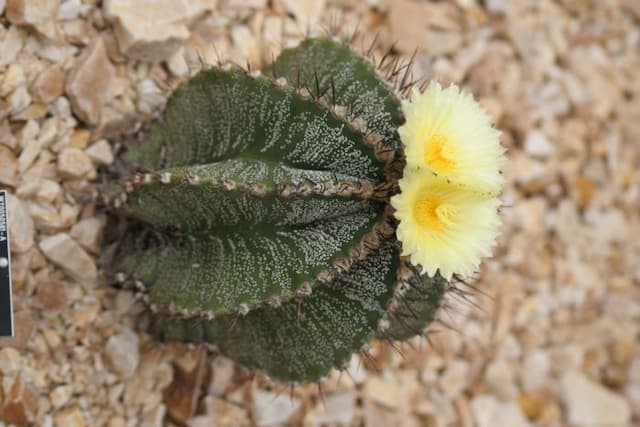Rebutia neocumingii subsp. pulquinensis

ABOUT
The plant known as the Crown Cactus has a strikingly spherical shape, often producing offsets and forming clusters that resemble a gathering of small, green balls. Its surface is densely covered in clusters of spines which offer a look of soft cushioning, although they are quite sharp. These spines emerge from areoles dotting the entire surface of the plant and range in color from white to yellow. The Crown Cactus blooms with an abundance of flowers, which is a delightful display. These flowers are typically large in comparison to the body of the plant, and they present themselves in a striking ring around the top, like a colorful crown. The petals are narrow and range in color from orange to bright red, creating a vibrant contrast with the green of the plant body. With its rich floral display and clustered growth habit, the Crown Cactus is an attractive addition to any collection of small, ornamental plants. Despite its small size, it brings a cheerful presence with its abundance of flowers and the intricate, rounded clusters it forms.
About this plant
 Names
NamesFamily
Cactaceae.
Synonyms
Orange Crown Cactus, Golden Crown Cactus, Lemon Ball Cactus.
Common names
Rebutia pulquinensis, Rebutia fiebrigii var. pulquinensis, Rebutia kariusiana.
 Toxicity
ToxicityTo humans
Rebutia neocumingii subsp. pulquinensis, commonly known as Crown Cactus, is not known to be toxic to humans. There is no widely reported toxicity from ingesting any part of this plant. However, it is generally advisable not to eat ornamental plants due to potential pesticide residue and the lack of information about their edible safety.
To pets
Crown Cactus is not known to be toxic to pets. There are no reported symptoms of poisoning from pets ingesting this plant. As with humans, it is often best to prevent pets from ingesting plants that are not confirmed to be safe, but ingestion of this particular cactus is unlikely to cause harm beyond the possibility of mechanical injury from its spines.
 Characteristics
CharacteristicsLife cycle
Perennials
Foliage type
Evergreen
Color of leaves
Green
Flower color
Red
Height
0.16 feet (5 cm)
Spread
0.16 feet (5 cm)
Plant type
Cactus
Hardiness zones
10
Native area
Bolivia
Benefits
 General Benefits
General Benefits- Aesthetic Appeal: The Crowns Cactus (Rebutia neocumingii subsp. pulquinensis) adds visual interest to any collection with its vibrant flowers and attractive form.
- Low Maintenance: Being a cactus, it requires minimal care, making it ideal for busy or forgetful gardeners.
- Drought Tolerance: It is highly drought-resistant, conserving water and thriving in dry conditions.
- Pollinator Attraction: The bright blooms attract pollinators such as bees, which are crucial for the environment.
- Suitable for Small Spaces: Its compact size makes it suitable for cultivation in small or confined spaces like apartments.
- Easy Propagation: It can easily be propagated from offsets or seeds, allowing gardeners to expand their collection or share with others.
- Therapeutic Gardening: The care routine of Crowns Cactus can be therapeutic, offering emotional and psychological benefits during cultivation.
- Educational Value: It can be used for educational purposes, teaching about plant care, arid ecosystems, and botany.
 Medical Properties
Medical PropertiesThis plant is not used for medical purposes.
 Air-purifying Qualities
Air-purifying QualitiesThis plant is not specifically known for air purifying qualities.
 Other Uses
Other Uses- Rebutia neocumingii subsp. pulquinensis, commonly known as Crown Cactus, can be used as a natural barrier when planted in clusters, due to its spiny nature deterring animals and possibly intruders.
- Crown Cactus, when potted creatively, can serve as a unique living art piece for interior decoration purposes, especially among succulent collectors.
- In educational settings, Crown Cactus is an excellent specimen to study the adaptations of plants to arid environments, offering a practical example for botany students.
- This cactus can be employed in terrariums or miniature gardens, where its small size and low water requirements allow it to thrive alongside other drought-tolerant plants.
- Crown Cactus is used to create themed plant collections, such as 'cacti gardens', which are popular among hobbyists who enjoy growing various cactus species.
- As a subject in photography, the distinctive appearance of Crown Cactus makes it suitable for macro photography and the study of plant textures and patterns.
- The colorful blooms of Crown Cactus can inspire artists and craftspeople, who might use its image in any number of creative works from paintings to textile patterns.
- The plant may also be used in xeriscape landscaping, an environmentally friendly approach that reduces or eliminates the need for supplemental water from irrigation.
- During certain holidays or festivities, Crown Cactus can be given as a lasting and sustainable alternative to traditional gifts like cut flowers.
- Enthusiasts of feng shui might use Crown Cactus, placing it in specific areas of the home to add 'wood' energy and as a symbol of resilience and persistence.
Interesting Facts
 Feng Shui
Feng ShuiThe Crown Cactus is not used in Feng Shui practice.
 Zodiac Sign Compitability
Zodiac Sign CompitabilityThe Crown Cactus is not used in astrology practice.
 Plant Symbolism
Plant Symbolism- Resilience: The Rebutia neocumingii subsp. pulquinensis, commonly known as the Crown Cactus, often thrives in harsh, rocky environments, symbolizing the ability to endure and prosper through tough conditions.
- Beauty and Humility: Despite growing in less-than-ideal circumstances, the Crown Cactus produces beautiful flowers, representing the idea that true beauty can exist without grandiosity and in humble settings.
- Adaptability: As a plant that can adapt to extreme changes in temperature and moisture, the Crown Cactus symbolizes flexibility and the capacity to adjust to various situations in life.
- Self-sufficiency: The ability of the Crown Cactus to store water and nutrients exemplifies independence and the ability to look after oneself without relying on external resources.
 Water
WaterCrown cactus requires moderate watering during its growing season (spring and summer) when the soil is completely dry to the touch; typically, this could be once every 7 to 10 days. Use a well-draining soil mix and water with approximately 4 ounces per session for a small pot. During winter, reduce watering to once a month as the plant enters dormancy. Overwatering can lead to root rot, so it's essential to ensure the pot has proper drainage.
 Light
LightCrown cactus thrives in bright, indirect sunlight and should be placed in a spot that receives plenty of light but is shielded from the most intense midday rays. A south or east-facing window that's covered with a sheer curtain would be ideal to provide the right amount of light without scorching the plant.
 Temperature
TemperatureCrown cactus prefers temperatures between 50°F and 75°F. It can survive minimum temperatures of 40°F and maximum temperatures of 90°F but will not tolerate frost. The ideal temperature range promotes healthy growth and blooming.
 Pruning
PruningCrown cactus generally requires little to no pruning. If necessary, prune to remove any dead or damaged spines or to maintain shape. The best time to prune is in the spring, but only if absolutely needed.
 Cleaning
CleaningAs needed
 Soil
SoilThe Crown Cactus prefers a well-draining soil mix, typically composed of a blend of potting soil, coarse sand, and perlite or pumice for added drainage and aeration. An ideal pH range for Rebutia neocumingii subsp. pulquinensis is around 5.5 to 6.5, slightly acidic to neutral.
 Repotting
RepottingCrown Cacti should be repotted every two to three years to refresh the soil and accommodate growth. It is best done during the plant's active growing season, usually in spring or early summer.
 Humidity & Misting
Humidity & MistingCrown Cactus thrives in low humidity conditions, typical of arid environments. It can tolerate indoor humidity levels but excessive moisture should be avoided.
 Suitable locations
Suitable locationsIndoor
Place in bright, indirect light with well-draining soil for successful indoor growth.
Outdoor
Ensure full sun to partial shade and protect from excessive moisture outdoors.
Hardiness zone
9b-11 USDA
 Life cycle
Life cycleRebutia neocumingii subsp. pulquinensis, commonly known as the Crown Cactus, begins its life as a seed, falling into the soil from the parent plant. With adequate warmth, moisture, and light, the seed germinates, typically in the spring, and a tiny cactus seedling emerges, sporting its first set of photosynthesizing spines. Over several years, the seedling grows into a mature cactus, characterized by a globular, green to bluish body often clumping together, with vibrant orange or red flowers blooming from the crown in late spring to early summer. After pollination by insects, the flowers develop into small, fruit-like structures containing seeds, thereby continuing the cycle. As a perennial, the Crown Cactus can live for many years, thriving in arid, well-drained conditions and requiring minimal water, a dormant winter period, and bright light to flourish. When the plant reaches the end of its life cycle, it will slowly decline and die, leaving seeds to potentially establish new plants.
 Propogation
PropogationPropogation time
Spring-Summer
The most popular method for propagating the Rebutia neocumingii subsp. pulquinensis, also known as the Crown Cactus, is through the use of offsets. These small baby plants, which form at the base of the mother plant, can be gently twisted off when they have formed a reasonable size, approximately 1/2 inch to an inch in diameter (about 1.25 to 2.5 centimeters). Once removed, the offsets should be allowed to dry for a couple of days to let the cut end callous over, reducing the risk of rot. They can then be potted in a well-draining cactus mix, lightly moistened, and placed in bright, indirect light. Rooting will generally occur within a few weeks, and after that, the young Crown Cacti can be cared for in the same manner as mature plants.









